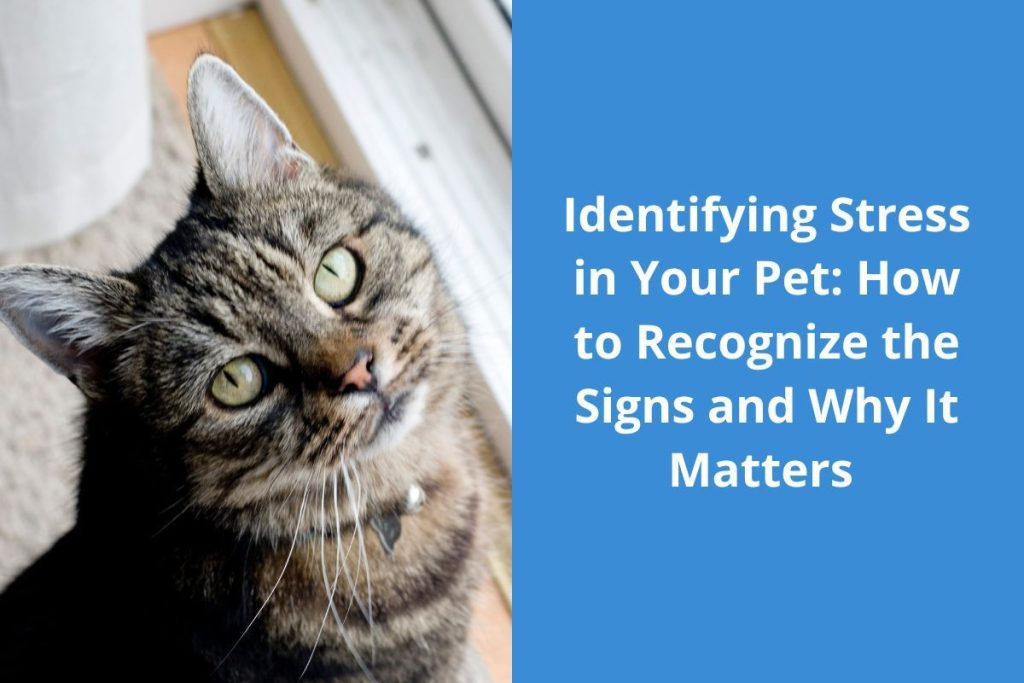Signs of Stress in Pets and How to Alleviate Them

Recognizing the Signs of Stress in Your Pet
Pets, like their human companions, are vulnerable to stress, which can significantly affect their well-being. Unfortunately, many pet owners may dismiss their animal’s stress signals, mistaking them for mere idiosyncratic behavior, when in fact, these indicators should prompt immediate attention. Identifying these signs is not just about understanding your pet better; it’s essential for ensuring their physical and emotional health.
Common Indicators of Stress
The manifestations of stress in pets can vary widely, but some common signs include:
- Excessive barking or meowing: This vocalization can indicate anxiety or a need for attention, often escalating when a pet feels threatened or neglected.
- Destructive behavior: Pets under stress may resort to chewing furniture, digging, or scratching. For example, a dog that chews on furniture may be reacting to separation anxiety.
- Withdrawal: If your pet suddenly begins to isolate themselves or hides away, it may be their way of coping with stress or discomfort.
- Changes in appetite: Stress can lead to overeating or complete loss of interest in food. A sudden weight loss or gain can be alarming and should be monitored closely.
- Unexplained aggression: Stress can make pets irritable, leading to sudden aggression towards humans or other animals they previously got along with.
Creating a Calming Environment
To effectively support stressed pets, awareness and proactive measures are essential. Alleviating their stress is a multifaceted approach, involving both environmental changes and behavioral modifications. Start by establishing a reassuring environment conducive to relaxation.
Here are some effective strategies to help mitigate stress:
- Maintain a consistent routine: Pets thrive on predictability. Regular feeding times and exercise schedules can make them feel more secure.
- Designate a safe space: Create a quiet nook equipped with cozy bedding and favorite toys where your pet can retreat when feeling overwhelmed.
- Utilize calming products: Consider pheromone diffusers or anxiety wraps that can have soothing effects. Many pet owners find success with these tools.
Understanding and addressing the signs of stress can foster a healthier environment for your pet, leading to a more fulfilling life. The bond between you and your furry friend can deepen when you take the steps to recognize and respond to their emotional needs. By prioritizing their mental wellness, you not only contribute to their happiness but also enhance your shared experiences, paving the way for a more harmonious household.

DIVE DEEPER: Click here to discover the benefits of clicker training
The Importance of Early Recognition
Understanding the signs of stress in pets is crucial for any responsible pet owner. Animals do not possess the same means of communication as humans, so they rely on their behavior to express their feelings. Pet stress can stem from various sources, including changes in their environment, loud noises, changes in routine, or even the introduction of new family members. Therefore, being vigilant and attuned to these subtle signals can make a significant difference in your pet’s quality of life.
Unpacking the Causes of Pet Stress
Stress in pets can arise from a multitude of situations, and recognizing the potential triggers is vital for prevention. Some common causes of stress include:
- Environmental Changes: Moving to a new home, rearranging furniture, or even new scents can unsettle a pet. They thrive on familiarity and can become anxious when their surroundings are altered.
- Separation Anxiety: Pets, particularly dogs, can experience stress when left alone for extended periods. Signs may manifest when they engage in excessive barking or destructive behavior, often seen in dogs that may not be accustomed to being alone.
- Social Encounters: Unfamiliar people or animals can trigger stress, especially in pets who are naturally shy or fearful. A sudden stranger approaching them or the presence of another pet can lead to signs of aggression or withdrawal.
- Health Issues: Sometimes, stress can be compounded by underlying health problems. Pets that are in pain or discomfort may exhibit anxiety, and addressing their physical health can have a profound impact on their overall stress levels.
Recognizing these stress triggers is the first step toward fostering a more harmonious living environment. It is essential to take note of any changes in your pet’s behavior, as each animal may exhibit unique signs of distress. A proactive approach includes observing how your pet reacts to different situations and being mindful of their body language. For instance, signs such as lowered ears, a tucked tail, or avoidance of eye contact are often indicators of a stressed pet.
Taking Action: How to Help Your Pet
Fortunately, alleviating stress in pets involves practical steps that can be implemented easily at home. Addressing the root causes of their anxiety can vastly improve their emotional well-being. Here are some actionable methods to reduce stress:
- Engage in Regular Playtime: Interactive play sessions can serve as an effective outlet for your pet’s pent-up energy, thereby reducing stress levels. Activities such as fetch or tug-of-war not only strengthen your bond but also provide mental stimulation.
- Consider Professional Help: If your pet displays persistent signs of stress, consulting a veterinarian or a pet behaviorist can provide tailored strategies based on your pet’s specific needs.
- Practice Positive Reinforcement: Rewarding your pet for calm behavior can encourage more relaxed interactions. Utilizing treats or praise can help them associate positive experiences with potentially stressful situations.
As a pet owner, your awareness is key in addressing stress and providing relief. By taking the time to recognize the signs of stress and implementing supportive measures, you contribute significantly to your pet’s emotional well-being and overall happiness. In the journey of pet ownership, nurturing your animal’s psyche is just as vital as attending to their physical needs.
Understanding Your Pet’s Stress Signals
Recognizing the signs of stress in pets is crucial for maintaining their well-being. Many pet owners may overlook subtle symptoms, unaware that their furry friends are experiencing distress. Common behaviors that indicate stress include excessive barking, hiding, changes in appetite, and destructive actions. Keeping an eye on your pet’s body language can also provide significant insights; for instance, a tucked tail or flattened ears often shows anxiety.In addition to recognizing these signs, it is essential to identify the triggers that cause stress. Changes in the environment, loud noises, or the introduction of new pets can significantly impact a pet’s mood. By conducting a thorough assessment of your pet’s lifestyle and surroundings, you can pinpoint potential sources of stress and take proactive measures.
Effective Strategies to Alleviate Stress
Once stressors are identified, various strategies can help alleviate your pet’s distress. Routine is key; pets thrive on predictability. Establishing consistent feeding, walking, and play schedules can create a sense of security. Additionally, providing a safe sanctuary where pets can retreat when feeling overwhelmed is beneficial. This could be as simple as a cozy bed in a quiet corner of the house.Another effective method includes engaging in positive reinforcement training. Rewarding your pet for calm behavior can help them associate previously stressful situations with positive experiences. Furthermore, consider incorporating relaxation techniques such as gentle massages or calming music designed specifically for pets. Enrichment plays a significant role in managing your pet’s stress levels. Interactive toys, puzzle feeders, and regular exercise can occupy their minds and bodies, distracting them from stressors. Lastly, don’t hesitate to consult a veterinarian if your pet’s stress seems persistent. Professional guidance may lead to tailored interventions, including behavioral therapy or medication if necessary. Addressing the signs of distress can lead to a happier, healthier pet.
DISCOVER MORE: Click here to learn about the benefits of companion animals
Assessing and Understanding Stress Behaviors
Recognizing stress in pets goes beyond just noticing behavioral changes; it involves understanding the context in which these behaviors occur. Pets may express their anxiety through various physical or emotional cues, and different breeds or species can exhibit unique signs. For example, while dogs might display stress through persistent barking or destructive chewing, cats may show their unease by hiding, excessive grooming, or even changes in litter box habits. Thus, it’s crucial to pay close attention to the specific signals your animal displays.
Physical Signs of Stress
Physical manifestations of stress can often be the most telling signs of discomfort in pets. You may notice:
- Excessive Grooming: Cats, in particular, groom themselves excessively when stressed, which can lead to bald patches or skin irritation.
- Changes in Appetite: A stressed pet may either eat less than usual or develop a ravenous appetite as a coping mechanism.
- Vocalization Changes: Increased vocalizations like whining or howling can indicate distress, especially in dogs.
- Restlessness or Lethargy: An anxious pet may pace or exhibit an inability to settle down, while some may retreat and become lethargic.
Notably, the interpretation of these signs can differ among individual pets. Factors such as breed, age, and overall temperament can influence how a pet displays stress, making it essential to familiarize yourself with your pet’s baseline behavior.
Environmental Enrichment: A Solution for Pet Stress
Implementing environmental enrichment in your home can significantly reduce stress for your furry companions. This can be achieved through various means, including:
- Interactive Toys: Puzzle toys that dispense treats can keep your pet mentally engaged and reduce feelings of boredom, which are often a precursor to stress.
- Safe Spaces: Create designated areas where your pet feels safe and secure, such as a cozy corner with their bed or favorite toys where they can retreat when feeling overwhelmed.
- Calming Products: Various products, such as calming collars, pheromone diffusers, and anxiety wraps, can help create a soothing environment for stress-prone pets.
- Routine and Consistency: Establishing a consistent routine can alleviate anxiety—a regular schedule for feeding, walks, and playtime can provide your pet with a sense of stability.
Furthermore, incorporating training sessions that reinforce positive behaviors can provide mental stimulation and a structured outlet for your pet’s energy. Activities such as obedience training or agility courses can not only enhance your pet’s skills but also strengthen the bond between you and alleviate stress.
Recognizing the Need for Professional Guidance
In some cases, despite your best efforts, a pet’s stress may persist or worsen. It’s essential to recognize when professional help is needed. Veterinarians can evaluate your pet for health-related issues contributing to their stress, while certified animal behaviorists can help develop customized behavior modification plans.
Moreover, some pets may benefit from anxiety-reducing medications prescribed by a veterinarian, especially if their stress leads to more severe behavioral problems or impacts their quality of life. Thus, taking an integrated approach that combines home strategies with professional advice can yield the best outcomes for your pet’s emotional health.
Ultimately, addressing stress in pets is a multifaceted endeavor that relies on awareness, understanding, and proactive engagement by pet owners. By remaining observant and informed, you can create a nurturing, supportive environment that promotes the well-being of your beloved companions.
LEARN MORE: Click here to discover how to protect your pet’s health
Conclusion
Understanding and addressing stress in pets is vital for fostering a healthy, happy environment for our furry companions. By recognizing the signs of stress, such as excessive grooming, changes in eating habits, vocalizations, and altered energy levels, owners can take proactive steps towards alleviating anxiety. Environmental enrichment, including interactive toys and safe spaces, plays a significant role in enhancing a pet’s quality of life and reducing stress levels.
Equally important is the establishment of routines that provide security and predictability for pets. This consistency can alleviate anxiety, making it easier for them to navigate daily life. Still, it’s essential to remember that not all stress issues can be resolved at home. When observing persistent or severe stress behaviors, seeking professional guidance from veterinarians or certified animal behaviorists is crucial. These experts can offer tailored advice and potential solutions, such as therapy or medication, when necessary.
In conclusion, an informed approach that combines awareness, engagement, and professional advice will empower pet owners to create an environment where their beloved animals can thrive. By remaining vigilant and responsive to their needs, we can effectively diminish stress and enhance the overall emotional well-being of our pets, reminding us of the profound bond we share with them.


